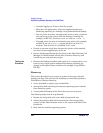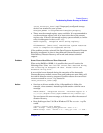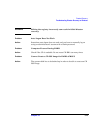
Disaster Recovery
Troubleshooting Disaster Recovery on Windows
Chapter 10516
Problem “No Operating System Found”
Action After performing disaster recovery, if the final boot of a Windows NT
system fails with “No Operating System Found”, check the boot.ini
file for information about where the partition information is located. See
Step 4 in the section “Recovery” on page 461 for additional information.
Problem Disk Delivery Disaster Recovery of a Media Agent Client
If you are performing a Disk Delivery disaster recovery, Data Protector
first tries to connect to the original client where the backup device was
attached (Media Agent client) in order to use the same device for restore.
However, when you are performing Disk Delivery disaster recovery of
the crashed Media Agent client where the backup has been made, Data
Protector will not be able to connect to it and will proceed with offline
restore and search for a local device for the restore. If there is no local
device attached, Data Protector will issue a notification that there is no
local device attached and will abort the disaster recovery.
Action There are three methods to avoid this:
• Move the media to another pool. This way you assign the media to the
new device. Then proceed with Disk Delivery disaster recovery.
• The third method involves preparation prior to the disaster. If you
have two Media Agent clients in the cell, you can back up of the first
Media Agent client to another and vice versa before the disaster to
avoid problems when performing Disk Delivery disaster recovery of a
Media Agent client.
Troubleshooting EADR and OBDR
Problem Automatic DR information could not be collected
When using EADR or OBDR, it is possible that you will receive the
following error: “Automatic DR information could not be
collected. Aborting the collecting of system recovery data”
Action • Check if all storage devices are configured correctly. If Device
Manager reports a device as “Unknown Device”, you have to install
the proper device drivers before you can perform EADR/OBDR. A
similar entry would appear in autodr.log (located in


















